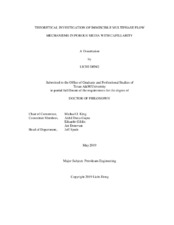| dc.description.abstract | The correct description of multiphase flow mechanism in porous media is an important aspect of research in fluid mechanics, water resources and petroleum engineering. The thorough understanding of these mechanisms is important for many applications such as waterflood, CO2 sequestration, and enhanced oil recovery. Being different from single phase flow that is well described by Darcy’s law and well understood for over 160 years, the multiphase flow mechanism requires more mathematical involvement with more complex fluid interaction which inevitably will incorporate relative permeability and capillary pressure into its description.
For typical two-phase flow problems, especially at the conventional reservoir scale, the Buckley-Leverett flow equations are normally applied with negligible capillarity to capture the flow behavior. However, as we extend our studies to higher resolution using multiscale calculations, or evaluate tighter or higher contrast heterogeneous reservoirs, capillarity becomes increasingly important. Also, for situations such as spontaneous imbibition that wetting fluid is displaced by non-wetting invading fluid, it is possible that capillary force becomes the dominating driving force with negligible viscous and gravity contributions. To better characterize the multiphase flow mechanism with capillarity, in this research, a detailed investigation is carried out in pursuit of more rigorous mathematical description and broader applicability.
The numerical simulation analysis of the described problem has long been a subject of interest with numerous publications addressing it. Being different from the traditional methods where numerical simulation is used, we pursue the analytical description of the flow behavior using Lagrangian approach which is better in describing these frontal propagation problems. Also, the analytical solution tends to give more insight into the underlying physical characteristics of the problem itself. As one of the most important outcomes, the methodology derives a new dimensionless capillary group that characterizes the relative strength of capillarity at the continuum scale based on the analytical solution. Knowledge of this can be used for stability analyses, with future potential application in the design of computational grids to properly resolve the capillary physics. | en |


